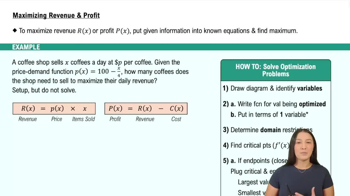Table of contents
- 0. Functions7h 52m
- Introduction to Functions16m
- Piecewise Functions10m
- Properties of Functions9m
- Common Functions1h 8m
- Transformations5m
- Combining Functions27m
- Exponent rules32m
- Exponential Functions28m
- Logarithmic Functions24m
- Properties of Logarithms34m
- Exponential & Logarithmic Equations35m
- Introduction to Trigonometric Functions38m
- Graphs of Trigonometric Functions44m
- Trigonometric Identities47m
- Inverse Trigonometric Functions48m
- 1. Limits and Continuity2h 2m
- 2. Intro to Derivatives1h 33m
- 3. Techniques of Differentiation3h 18m
- 4. Applications of Derivatives2h 38m
- 5. Graphical Applications of Derivatives6h 2m
- 6. Derivatives of Inverse, Exponential, & Logarithmic Functions2h 37m
- 7. Antiderivatives & Indefinite Integrals1h 26m
- 8. Definite Integrals4h 44m
- 9. Graphical Applications of Integrals2h 27m
- 10. Physics Applications of Integrals 2h 22m
5. Graphical Applications of Derivatives
Applied Optimization
Problem 76b
Textbook Question
Turning a corner with a pole
What is the length of the longest pole that can be carried horizontally around a corner at which a corridor that is a ft wide and a corridor that is b ft wide meet at right angles?
 Verified step by step guidance
Verified step by step guidance1
First, visualize the problem: You have two corridors meeting at a right angle, one is 'a' feet wide and the other is 'b' feet wide. You need to find the longest pole that can be carried horizontally around this corner.
Consider the pole as a line segment that needs to navigate the corner. The pole will touch the inner corner and the outer walls of the corridors. The key is to find the maximum length of this line segment.
Use the concept of similar triangles and geometry. The pole will form a right triangle with the walls of the corridors. The hypotenuse of this triangle is the pole, and the legs are the distances from the corner to the point where the pole touches the walls.
Set up the equation using the Pythagorean theorem. If the pole touches the walls at points (x, 0) and (0, y), then the equation is: <math xmlns="http://www.w3.org/1998/Math/MathML"><mrow><msqrt><mrow><msup><mi>x</mi><mn>2</mn></msup><mo>+</mo><msup><mi>y</mi><mn>2</mn></msup></mrow></msqrt></mrow></math>. You need to express x and y in terms of 'a' and 'b'.
To maximize the length of the pole, use calculus to find the critical points of the function derived from the geometry. This involves taking the derivative of the function with respect to x or y, setting it to zero, and solving for the maximum length.
 Verified video answer for a similar problem:
Verified video answer for a similar problem:This video solution was recommended by our tutors as helpful for the problem above
Video duration:
11mPlay a video:
Was this helpful?
Key Concepts
Here are the essential concepts you must grasp in order to answer the question correctly.
Geometric Optimization
Geometric optimization involves finding the maximum or minimum values of a function subject to certain constraints. In this problem, we need to determine the longest pole that can fit around a corner, which requires analyzing the geometric relationship between the pole and the corridors' widths.
Recommended video:

Intro to Applied Optimization: Maximizing Area
Pythagorean Theorem
The Pythagorean Theorem states that in a right triangle, the square of the length of the hypotenuse is equal to the sum of the squares of the lengths of the other two sides. This theorem is essential for calculating the effective length of the pole as it turns the corner, allowing us to relate the widths of the corridors to the pole's length.
Recommended video:

Fundamental Theorem of Calculus Part 1
Calculus of Variations
Calculus of variations is a field of mathematical analysis that deals with optimizing functionals, which are mappings from a set of functions to real numbers. In this context, it helps in determining the optimal shape or path that the pole must take to maximize its length while navigating the corner formed by the two corridors.
Recommended video:

Fundamental Theorem of Calculus Part 1

 1:13m
1:13mWatch next
Master Intro to Applied Optimization: Maximizing Area with a bite sized video explanation from Callie
Start learningRelated Videos
Related Practice








